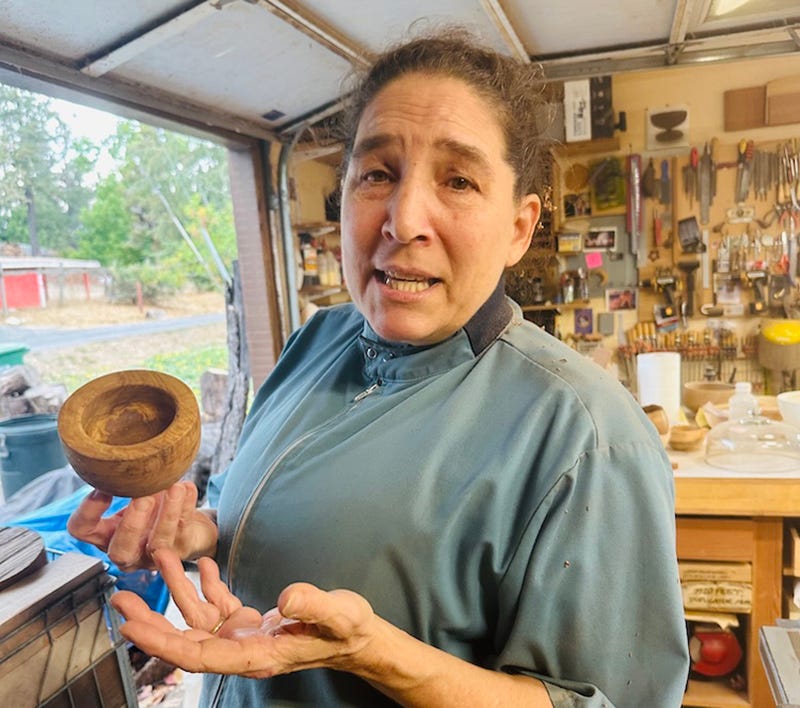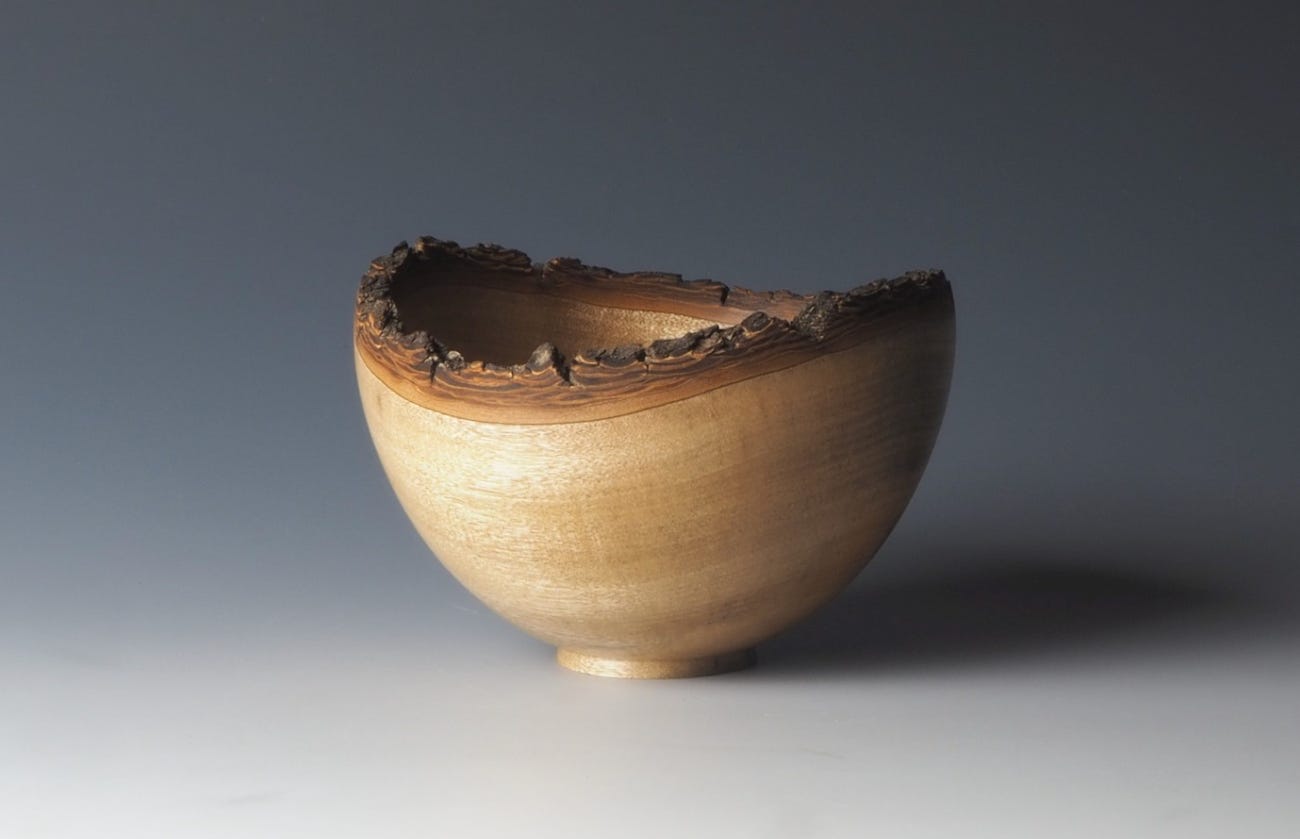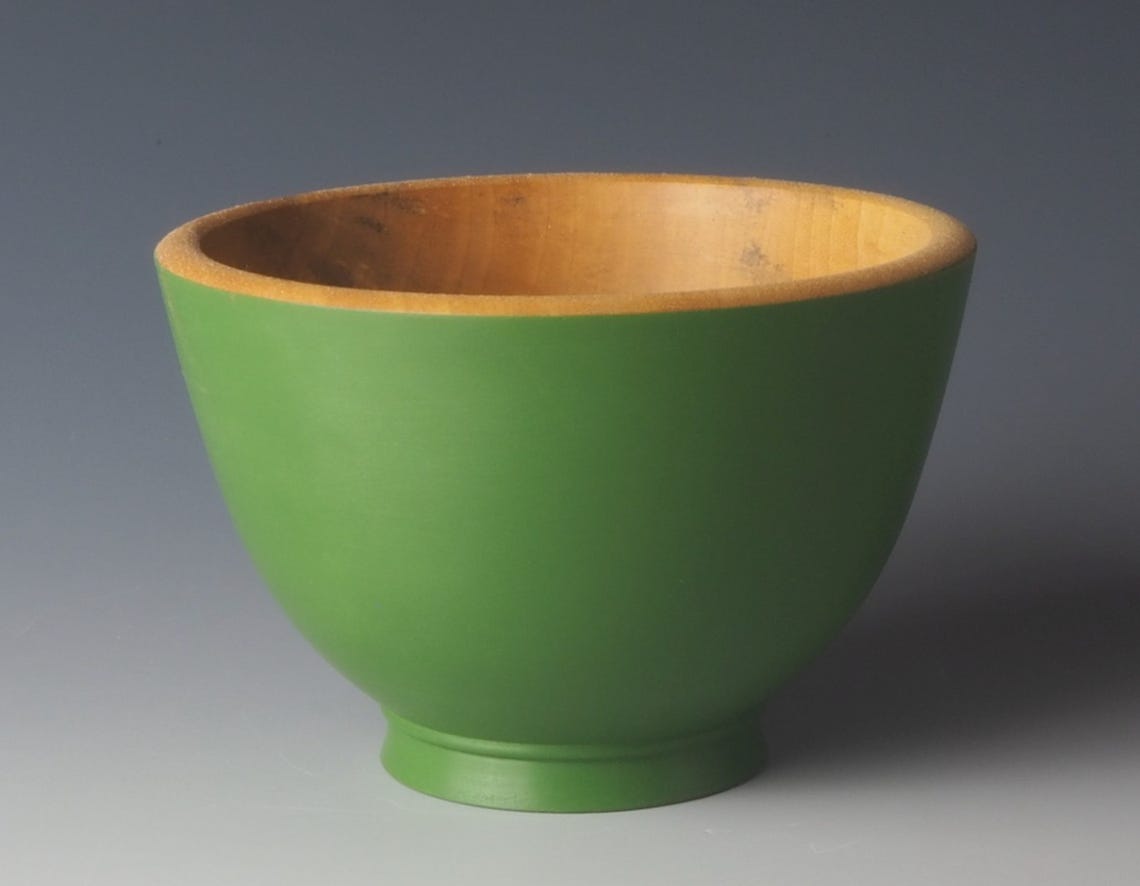The Bones of Trees
Local woodturner Kalia Kliban is showing her exquisite bowls at Sebastopol Gallery for the next two months and doing live woodturning in the front window all this week

Sebastopol attracts a large number of talented artists and musicians — one might even say that’s its primary draw to the outside world. Woodturner Kalia Kliban is one such creative. Some locals may know her through her popular classes at Chimera Arts Makerspace or through her longtime association with the Bay Area traditional dance community. Most probably know her through her displays at Sebastopol Gallery at 150 N. Main St., where her current show, “The Bones of Trees,” runs from Sept. 29 to Nov. 29.
This week, Kliban will give live woodturning demonstrations in the front window of the gallery from 10 am to 5 pm each day, except Sunday when she’ll knock off at 3 pm to get ready for her free artist talk, “From the Tree to the Bowl,” from 5 pm to 6:30 pm.
Kliban was born and raised in Fairfax by cartoonist parents in a highly creative household. (Readers may remember her father B. Kliban, famous for his cat cartoons.) Kliban herself earned a degree in graphic design at the California College of Arts and Crafts — now known as the California College of the Arts — in Oakland.
Her professional woodworking experience in the following years included working for two guitar makers in the East Bay and repairing guitars for Amazing Grace Music in San Anselmo. After that she built cabinets and furniture for eight years at Design In Wood Inc. in Petaluma. Along the way, she moved to Sebastopol with her husband in 1998.
“There were things about cabinet and furniture making that I absolutely loved,” Kliban said. “I liked the precision of it. I really enjoyed the problem solving as well. I was the nitpicky details person who was really good at weird joinery — the thousand-tiny-pieces jobs.”
Her foray into woodturning — heretofore a hobby — began in earnest in 2010 when the 2008 economic downturn hit Design In Wood, and she took the opportunity to join Sebastopol Gallery and sell her bowls as a business. Since then, she’s primarily split her professional life between turning bowls and calling at traditional dances.
Per her website, “While it was Irish ceilidh dancing at the Starry Plough pub in Berkeley that first drew me in, at one time or another I’ve performed or taught morris dancing, longsword, rapper sword, English and American clogging, and called for English country, contra, and family dances.”
Additionally, Kliban began teaching bowl making at Chimera in 2022 and found yet another passion in doing so.
“I love it. It’s an amazing bunch of folks,” she said. “My classes always sell out, and there’s a limit to how many classes I can teach in a month. So right now, I can only take two students at a time. I’m hoping — fingers crossed — to schedule more classes for next year.”
She will primarily be selling both functional and ornamental bowls at her upcoming show at Sebastopol Gallery. Pricing varies from $30-$40 for smaller or very simple pieces, to up to $900-plus for pieces that are large, made of particularly nice woods or that require a lot of handwork.
The bowl-making process involves time and exquisite attention to detail. Kliban begins by finding free greenwood in the local community and splitting the logs lengthwise. Then she cuts blanks and turns them each on a lathe till they are crude “larval” bowls. She dries them each for up to two years before again turning these larval bowls on the lathe and shaping them to completion.

Some bowls are fully formed at this point. But others, those that have handles for instance, then require extensive shaping with a rasp to become perfectly rounded and blemish-free.
“Your hands can see things your eyes can’t see,” she said. “You will work [on a bowl] till you cannot feel irregularities. Something like this takes an infuriating amount of handwork.”
Finally, the bowls are given a protective finish — flaxseed oil or walnut oil for food bowls and any number of different coats for ornamental ones.
“All of the bowls come with a care sheet,” Kliban said, noting that after the first couple of washes bowls should receive some maintenance. “What I recommend people do is just give them a little wipe with 400- or 600-bit sandpaper that’ll take the fuzzies off, and then just rub in a few drops of either flaxseed or walnut oil.”
Here’s video of her turning wood:
Kliban is as passionate about bowl making as she is about the finished product. Bowls are, after all, a process. Perhaps she best summed up her feelings on the subject with the words: “I think that most people my age or younger don’t have enough experience of making physical things, especially people who grew up with so much online stuff. It’s kind of an alien experience, and it’s something everybody should get a chance to try.
“I also think that way too many adults don’t let themselves be beginners. If they aren’t perfect at it, it’s like, ‘No, no, I’m not good at it, so I can’t do this.’ So when somebody takes a class, they get to do something they’ve never done before, and they’re using tools they’ve never used and skills they’ve never used with a material they may have never worked with. And they walk out of my class with a bowl, and it can be a lumpy bowl, and that’s okay. It’s bowl No. 1, right?”
“The Bones of Trees” runs from Sept. 29 to Nov. 29. Kliban will give live woodturning demonstrations this week in the front window of the gallery from Sept. 29 to Oct. 5. On Sunday, Oct. 5, she’ll also give a free artist talk, “From the Tree to the Bowl” from 5 pm to 6:30 pm. On Oct. 24 the Sebastopol Gallery will host a reception from 4 pm to 6 p.m. More information about Kalia Kliban’s current show and bowl making can be found at www.sebastopolgallery.com, www.kaliakliban.com, Instagram: kaliakliban and facebook.com/kkbowls.






